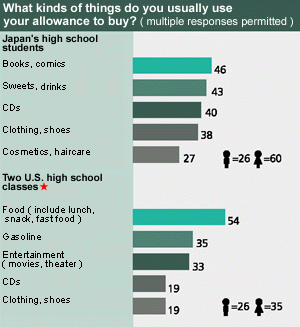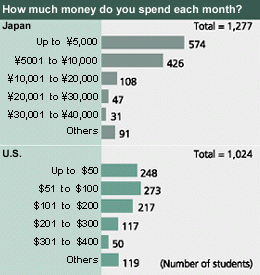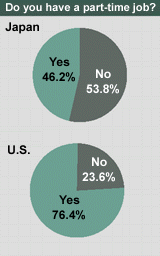
 |
| photos: Hongo Jin / illustrations: Asayama Yuki |
| How much money do high school students use for daily expenses? Where do they get such money? This issue takes a look at the allowance books of four Japanese high school students. We also collected data on the allowances of some students in high schools in the United States and Australia. What sorts of things do you notice from this information? This topic gives us a chance to zoom in the sorts of things high school students buy and the activities they are involved in. |
 O-kozukai ( allowance ): High school students receive spending money from their parents in various ways. Some get a set amount from their parents on a specified day; others receive cash when they need it for particular expenses, and so on. According to one survey,* the largest proportion, or some 38.5 percent, of Japanese high school students receive an average monthly allowance of between 4,000 and 5,000 yen. O-kozukai ( allowance ): High school students receive spending money from their parents in various ways. Some get a set amount from their parents on a specified day; others receive cash when they need it for particular expenses, and so on. According to one survey,* the largest proportion, or some 38.5 percent, of Japanese high school students receive an average monthly allowance of between 4,000 and 5,000 yen.
* Karaza Report '99 vol. 3, Kumon Children's Research Institute, 1999. |
|
Let's take a look at monthly accounts of ... | |
  Kotaro, 16, first-year, private high school, boy, Tokyo Details of Kotaro's Accounts |
  Yu, 17, second-year, private high school, girl, Saitama prefecture Sample of Yu's Monthly Accounts |
  Shunsuke, 18, third-year, public high school, boy, Chiba prefecture Sample of Shunsuke's Monthly Accounts |
  Ryo, 17, second-year, public high school, girl, Hokkaido Sample of Ryo's Monthly Accounts |
| Data and activities | |
 data1 |
 data2 |
 Based on data from 61 students in 2 classes obtained with the coopration of Joanne Shaver, Japanese-language teacher at a public school in the state of Virginia, U.S.A. In Virginia, students can get a driver's permit at 15 ( allowing them to drive with a licensed driver in the car ) and a license at 16 years.The average allowance in these classes was US$200. Of 61 students 54 had part-time jobs. Based on data from 61 students in 2 classes obtained with the coopration of Joanne Shaver, Japanese-language teacher at a public school in the state of Virginia, U.S.A. In Virginia, students can get a driver's permit at 15 ( allowing them to drive with a licensed driver in the car ) and a license at 16 years.The average allowance in these classes was US$200. Of 61 students 54 had part-time jobs.
data1 Karaza Report' 99 vol.3, Kumon Children's Research Institute, 1999. data2,3 Chuugakusei kookoosei no nichijoo seikatsu ni kansuru choosa hookokusho [ Report of the Study on Youth and Mobile Phone Use ], Japan Youth Research Institute, 2000. |
 data3 |
 Data provided by Julia Clancy of Wangaratta, Australia. |
Let's Try !
|
|
|
TJF would like to express its special thanks to the four Japanese high school students, and to Joanne Shaver of the United States, and Julia Clancy of Australia for helping to collect data for this issue's A Day in the Life. The photographs in this feature are drawn from the TJF Photo Data Bank. Note that the four students featured in the text are not those appearing in the photographs. |
||
Original text : The Japan Forum Newsletter no20 "A day in The Life" March 2001.
Send feedback to forum@tjf.or.jp